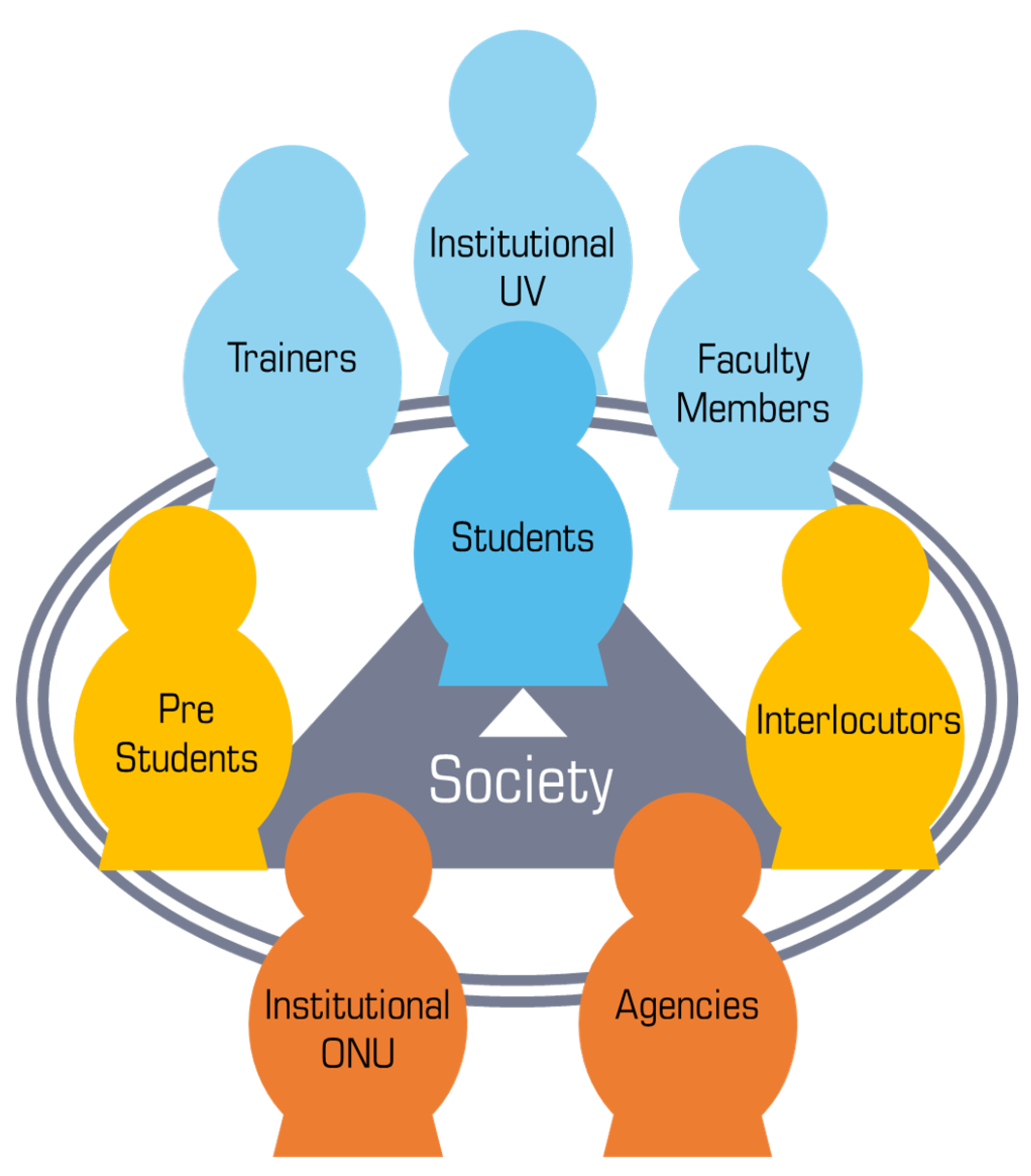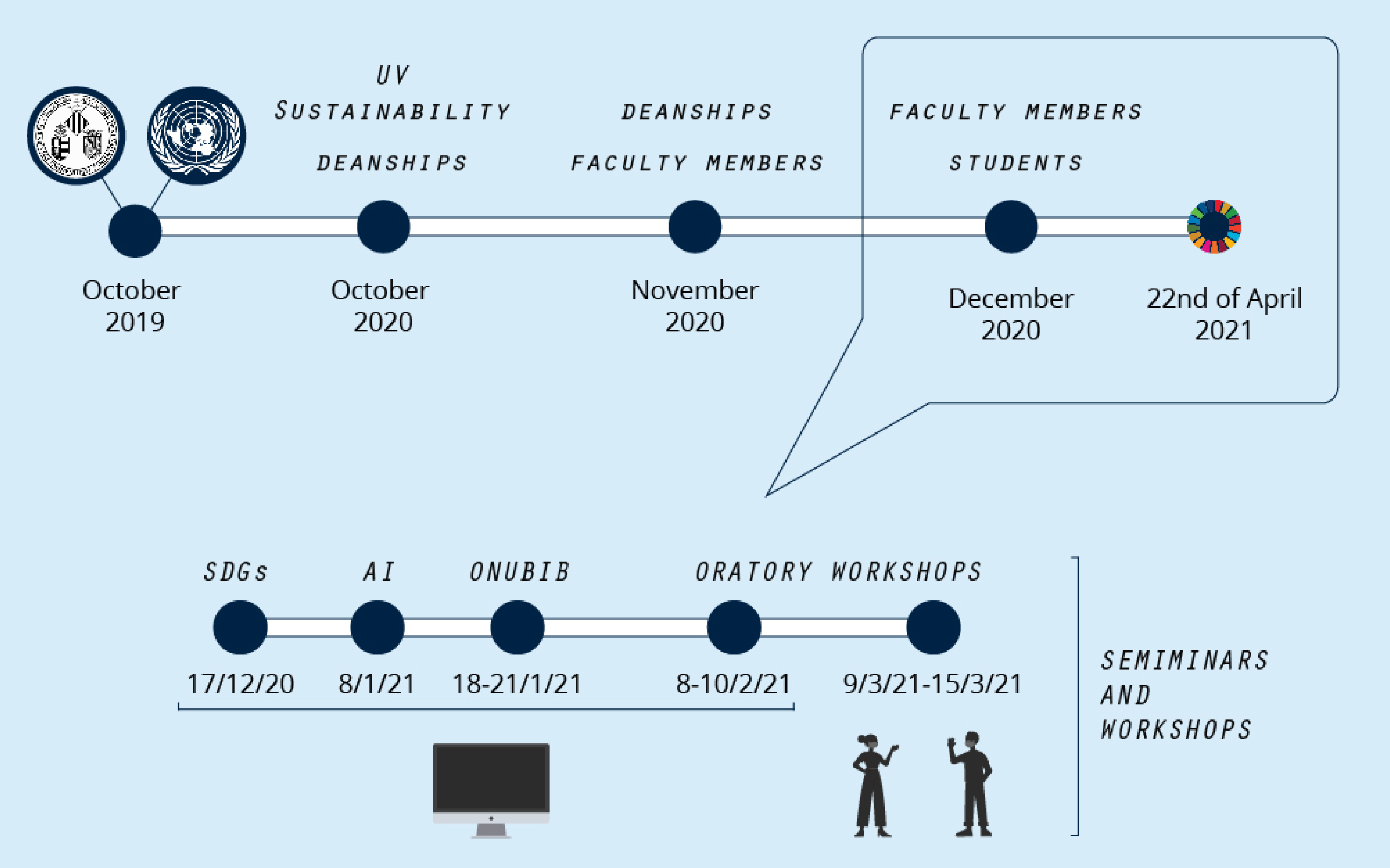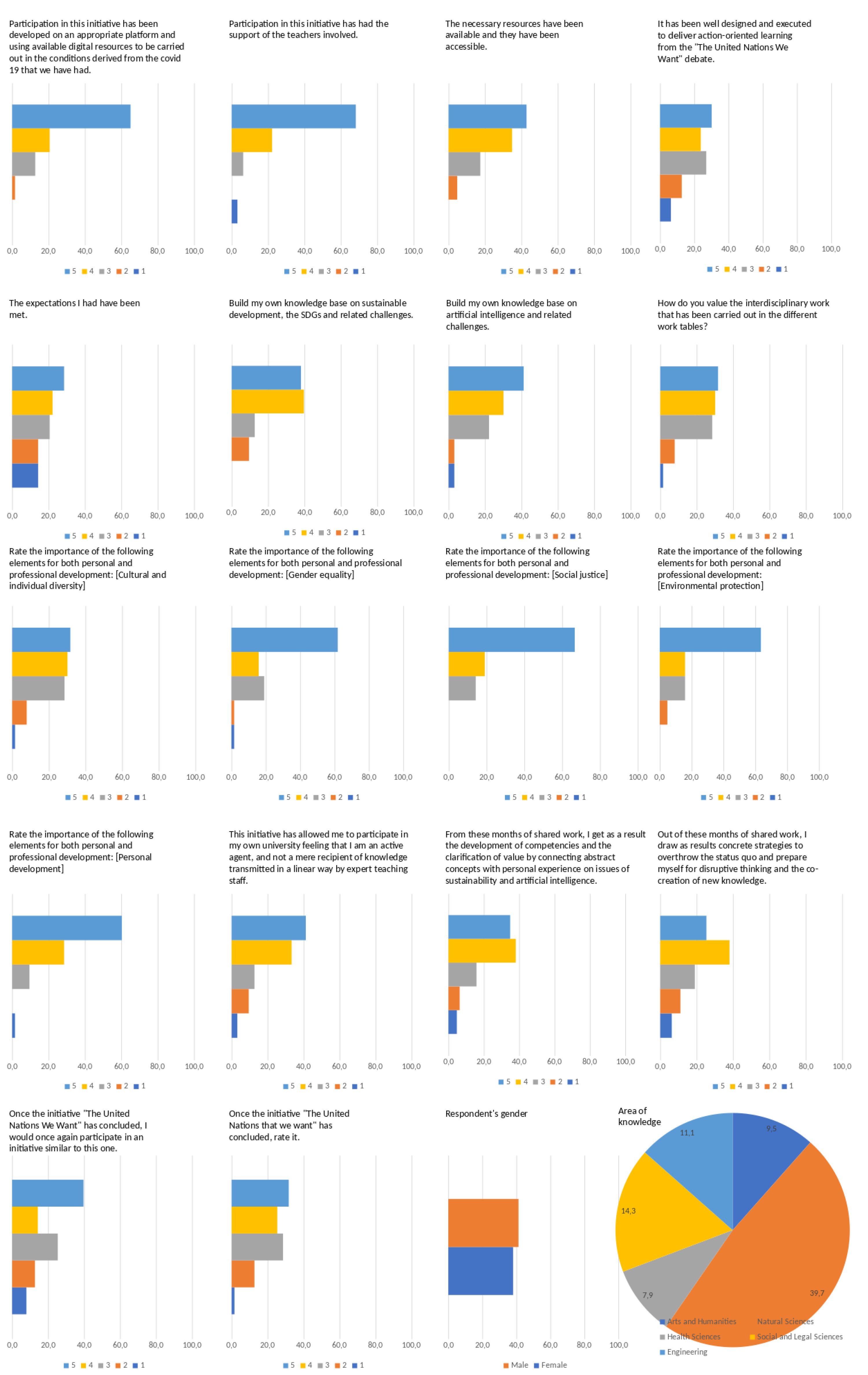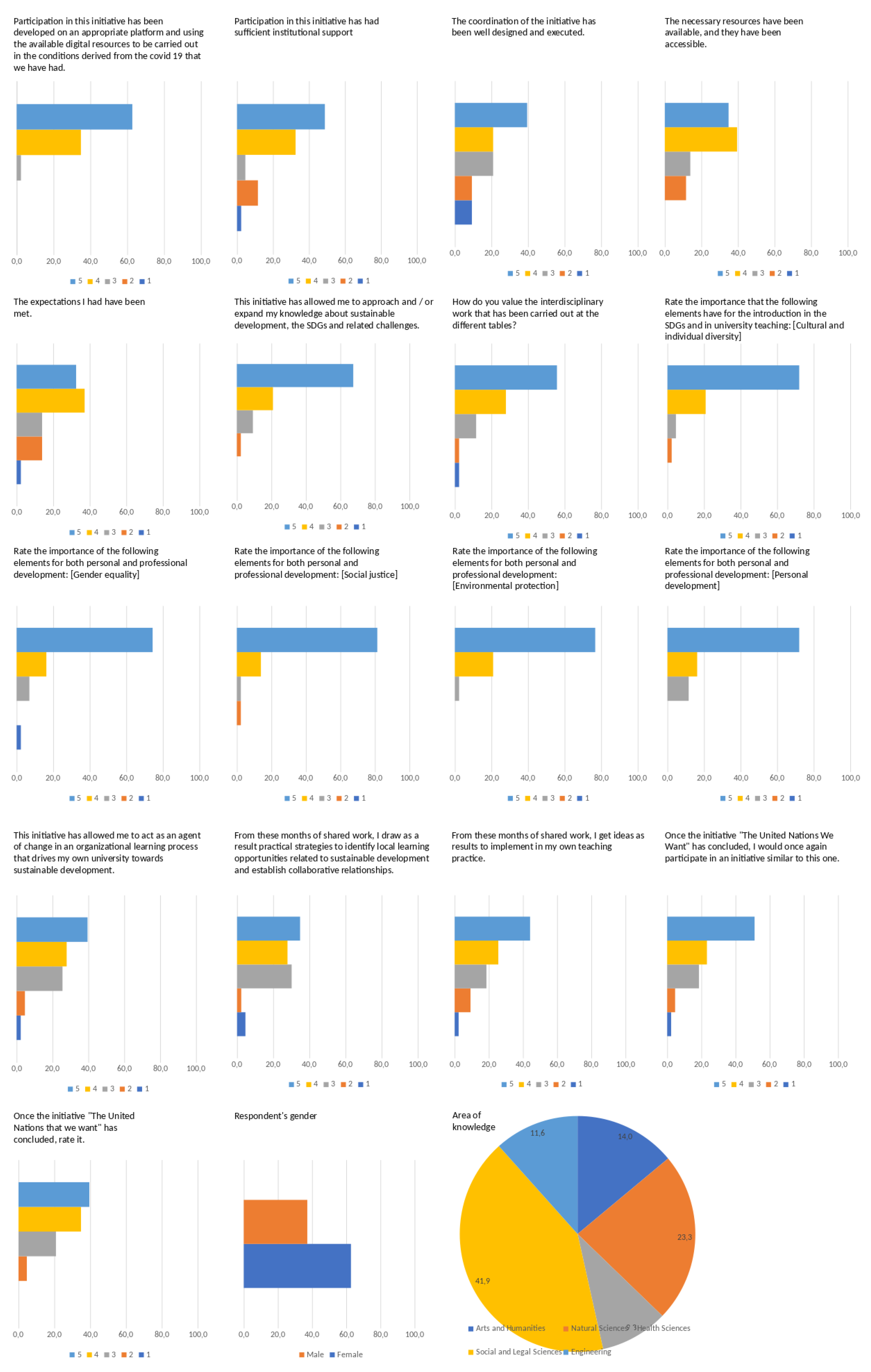The Future We Want: A Learning Experience to Promote SDGs in Higher Education from the United Nations and University of Valencia
Abstract
:1. Introduction
General Introduction about the Role Universities Can Play in the 2030 Agenda
“The world is changing faster than ever before, and we are flooded by impossible amounts of data, of ideas, of promises, and of threats. Humans relinquish authority to the free market, to crowd wisdom, and to external algorithms partly because they cannot deal with the deluge of data. In the past, censorship worked by blocking the flow of information. In the twenty-first century, censorship works by flooding people with irrelevant information. People just do not know what to pay attention to, and they often spend their time investigating and debating side issues. In ancient times, having power meant having access to data. Today, having power means knowing what to ignore. Thus, considering everything that is happening in our chaotic world, what should we focus on?”.([1], p. 430)
2. The UN That We Want
2.1. Background and Motivation
“Subject disciplines, subject didactics, educational sciences and practice-oriented studies should include methodology principles and subject knowledge from ESD. Learning on the basis of real societal challenges in local contexts requires cooperation with external partners. Modules should thus enable access to external partners”.([18], pp. 51–52)
2.2. Artificial Intelligence as a Pivotal Topic
- Science and technology for the fulfilling of SDG’s and the mitigation of climatic change.
- Artificial Intelligence in a finite planet: challenges posed by the 2030 Agenda.
- Opportunities and challenges of Education of Sustainable Development: the digital era from the ethic, historical, and anthropological perspectives.
- Human rights and Artificial Intelligence at the service of the 2030 Agenda.
2.3. Contents and Objectives: Artificial Intelligence and Transversal Competencies for Curricular Sustainability
- The complexity of the Climate System, interactions between its components and feedback processes at different spatial and temporal scales;
- The interactions of productions chains based on AI and its impacts on the planet and people;
- The financialization of the global economy and the complexity of insubstantial paper values that endanger the livelihoods of billions of people;
- Relationships in Planet Earth and the significance of human actions;
- The search for nature based solutions to many of the planet problems;
- Interest of applying Earth Observation remote sensing techniques for different indicators;
- Understanding and managing uncertainty as unavoidable risk-taking and risk-sharing also considering the cost of being reluctant to acting.
- Analyzing past World Economic Forum global risks (economic, environmental, geopolitical, societal, and technological) forecasts seeing how they have evolved in the last few years, also considering the unforeseeable COVID-19 pandemic;
- Learn to anticipate unintended consequences, and to conceptualize, construct, and communicate the probable fundamental characteristics of the future;
- Anticipate the effect of AI on the different SDGs. Towards gaining more knowledge and predictive capacity;
- Learn the technique for building different scenarios: What would happen if …?
- Precautionary principle based on risk analysis, trusting science, balance between preventive actions and innovation;
- Again, consider the cost of inaction.
- Ability to negotiate sustainability values, achieve country coalitions;
- Role of non-governmental and Intergovernmental Organizations;
- Ethical issues. Scope and limitations of AI;
- Significant role played by the Law lecturers in the team by establishing the ethics underlying the different AI algorithm applications, defending privacy and right to privacy.
- Ability to connect AI (technology) to the social world. Capacity (readiness) of technology to evolve with time and facilitate adaptation to changes;
- Sustainable technology;
- Capacity to communicate sustainable concern for general public and neutralize fake news.
- Managing multidisciplinary teams;
- Teamwork capabilities, active listening, managing conflict, consensus building, etc.;
- Faculty members and students working together: faculty members showing different alternatives or providing knowledge but adapting themselves to the students’ working dynamics, using their communication and virtual meeting tools, for example;
- Leadership attitudes and aptitudes;
- Define the role of the group representatives.
- Absolutely needed when the amount of information is massive;
- Ability for analysis, synthesis, problem identification and problem solution, evaluation;
- To be open-minded, tolerate opposing opinions;
- Thinking outside the box;
- Capacity for adaptation to different options arising and eventual evolution or changes of the activity itself;
- To promote abilities for the students to examine their own thinking, and that of others, about information that they receive through observation, experience, and formal research papers.
- Probably one of the most innovative characteristics of this learning process, achieved by inciting and facilitating the self-management of the group so that the students themselves devised their own way of training, distributing the work, electing their representatives, etc.;
- Ability to put oneself in place of the other and start by applying the contents personally;
- Recognizing the role of each student’s values, feelings, interests, abilities, and multiple identity facets when shaping one’s thoughts and actions and, this, through sustained engagement over the months dedicated to prepare the debate with frequent meetings that helped them develop and express self-awareness;
- Students were exposed to what they were competent in and what they could improve on the different seminars and meeting held during the preparation weeks.
- Multidisciplinary and interdisciplinary teams;
- Integrating problem analysis, AI, and Earth Observation techniques sustainability assessment, etc.;
- Play the stakeholder role or responsibility to assess effective sustainable solutions;
- Prepare joint argumentation and group reports.
2.4. Organization and Scheduling
3. Methodologies and Actions
3.1. Discussion Panels
3.1.1. Panel A
- First seminar: it was thought to be convenient to dedicate one of the first training seminars to the synergistic action of AI and Earth Observation to driving and attaining the specific SDGs under consideration. This seminar was given by a faculty member of the Physics Faculty whose main area of research and expertise is Remote Sensing.
- Second seminar: The second seminar was aimed at explaining basic concepts like signal, sensor, distributed sensing, data digitization and their safe transmission and how these concepts are physically implemented (Internet of Things, smart sensorization, data aggregation, and verification through blockchain techniques). In addition, some aspects were discussed about privacy implications. This seminar was given by a faculty member of the School of Engineering.
- Third seminar: A seminar on visual health cooperation was given by a faculty member of the Physics Faculty who has experience on this topic. She also showed significant personal volunteer actions carried out in low- and middle-income countries.
- Fourth seminar: This seminar was devoted to understanding the principle and actions to achieve a sustainable city, as well as learn about new movements such as slow cities. The goal is to achieve more sustainable and inclusive cities from a social, economic, and environmental point of view. This seminar was given by a faculty member of the Faculty of Geography and History.
- Fifth seminar: the main purpose of the seminar was to analyze the possibilities and risks of the use of AI from a legal perspective. This seminar was directly related to SDSs 6, 11, 13, 14, and 15.
- Sixth seminar: In this seminar, different subjects were explained around getting more women into science and engineering careers to achieve better science. This seminar was given by a faculty member of the Faculty of Physics who is an expert in gender equality.
- How AI tools can be applied to the environment and the impact they may have.
- Data and its impact on environment and law issues implied.
- Training and education: raise the importance of education and training to achieve a more sustainable planet.
- The increase of transport for tourism purposes leads to a substantial increase in CO2 emissions into the atmosphere.
- The technology, and in particular data exploitation and storage centers, increase water stress and greenhouse gas emissions, coming into conflict with local resources and the environment.
- Tourism is responsible for the majority of the residuals found in oceans.
- Tourism promotes the touristification of cities or certain neighborhoods, and with it the right of residents to access housing is violated (contemplated as goal in SDG 11), thus becoming unsustainable cities.
- A tourist at the Community of Valencia may spend four times more water than a common citizen, therefore breaking the water balance in one of the regions with most frequent droughts in Spain.
3.1.2. Panel B
- Technological growth of businesses and the future of employment,
- Data protection and privacy infringement,
- Equal energy and technological development among countries.
3.1.3. Panel C
- Question 1:
- What tools and creation of international alliances can the UN stimulate to promote cultural, social, and economic change that promotes well-being, the reduction of inequalities and justice in the digital age? (SDG 17)
- Question 2:
- What are the social, psychological, economic, and ethical consequences of digitization in work and education? (SDG 4)
- Question 3:
- How do AI and digitalized environments affect the environmental impact of capitalist production and consumption models? (SDGs 1 and 2)
- Question 4:
- How can the great benefits of AI be used to solve poverty and fight the rejection of the poor (aporophobia)? (SDGs 1 and 2)
3.1.4. Panel D
- Question 1:
- How can AI benefit healthy living?
- Question 2:
- We believe that the UN should lead the standard of healthy living with respect to different people, cultures, etc.
- Question 3:
- How can AI support sanitary procedures, diagnosis, treatment, and surgery?
- Question 1:
- Is ethical and diversity training necessary to develop a human AI?
- Question 2:
- What kind of training are AI professionals receiving about ethics and diversity?
- Question 3:
- What kind of education do we receive about managing our data and privacy on the Internet?
- Question 4:
- How could the UN regulate intervention, control, or define limits in AI?
4. Assessment of the Process of Participation
5. Learning Results
- I.
- Addressing the challenges of Artificial Intelligence societies and technologies facilitated learning objectives for Education for SDGs.
- II.
- The dialogue between internal and external agents provoked high quality debate for understanding the artificial intelligence’s challenges, opportunities, and interactions between the SDGs.
- III.
- Working with common horizons empowered youth and promoted necessary social impacts for sensitive responses.
6. Conclusions
Author Contributions
Funding
Institutional Review Board Statement
Informed Consent Statement
Data Availability Statement
Acknowledgments
Conflicts of Interest
Abbreviations
| SDG | Sustainable Development Goals |
| CEO | Chief Executive Officer |
| UN | United Nations |
| UV | University of Valencia |
| AI | Artificial Intelligence |
| UNTWO | United Nations World Tourism Organization |
| UPOV | International Union for the Protection of New Varieties of Plants |
| FAO | United Nations Organization for Food and Agriculture |
| ILO | United Nations International Labour Organization |
| ESD | Education for Sustainable Development |
| ONUBIB | Deposit Library of UN at University of Valencia |
| UNESCO | United Nations Organization for Science and Culture |
| IESALC | UNESCO International Institute for Higher Education in Latin-American and Caribbean |
| SGITT | UN Service for Geospatial, Information, and Telecommunications Technologies |
| UN DESA | United Nations Department of Economic and Social Affairs |
| UNITAR | United Nations Institute for Training and Research |
| LMS | Learning Management System |
| CMS | Content Management System |
References
- Harari, Y. Homo Deus: A Brief History of Tomorrow; Harper-Collins: New York, NY, USA, 2016. [Google Scholar]
- Kestin, T.; van der Belt, M.; Denby, L.; Ross, K.; Thwaites, J.; Hawkes, M. Getting Started with the SDGs in Universities; Sustainable Development Solutions Network (SDSN): Melbourne, Australia, 2020. [Google Scholar]
- Mochizuki, Y. Educating for Transforming Our World: Revisiting International Debates Surrounding Education for Sustainable Development. Curr. Issues Comp. Educ. 2016, 19, 109–125. [Google Scholar]
- Miñano, R.; García Haro, M. Implementando la Agenda 2030 en la Universidad. Casos Inspiradores. In Technical Report, Red Española para el Desarrollo Sostenible (REDS); REDS: Madrid, Spain, 2020; Available online: https://reds-sdsn.es/wp-content/uploads/2020/05/Dosier-REDS_Casos-ODS-Univ-2020_web.pdf (accessed on 28 July 2021).
- Blanco-Portela, N.; Poza-Vilches, M.F.; Junyent-Pubill, M.; Collazo-Expósito, L.; Solís-Espallargas, C.E.A. Estrategia de investigación-acción participativa para el desarrollo profesional del profesorado universitario en educación para la sostenibilidad. Profr. Rev. Curric. Form. Profr. 2020, 24, 99–123. [Google Scholar]
- Ferguson, T.; Roofe, C.G. SDG 4 in Higher Education: Challenges and Opportunities. Int. J. Sustain. High. Educ. 2020, 21, 959–975. [Google Scholar] [CrossRef]
- Heleta, S.; Bagus, T. Sustainable Development Goals and Higher Education: Leaving Many Behind. High. Educ. Int. J. High. Educ. Res. 2021, 81, 163–177. [Google Scholar] [CrossRef]
- Younie, S.; Audain, J.; Eloff, I.; Leask, M.; Procter, R.; Shelton, C. Mobilising Knowledge through Global Partnerships to Support Research-Informed Teaching: Five Models for Translational Research. J. Educ. Teach. Int. Res. Pedagog. 2018, 44, 574–589. [Google Scholar] [CrossRef]
- Bautista-Cerro Ruiz, M.J.; Murga Menoyo, M.A.; Novo Villaverde, M. La educación ambiental en el siglo XXI (página en construcción, disculpen las molestias). Rev. Educ. Ambient. Sostenibilidad REAYS 2019, 1, 1103–1114. [Google Scholar]
- Lafuente-Lechuga, M.; Cifuentes-Faura, J.; Faura-Martínez, U. Mathematics Applied to the Economy and Sustainable Development Goals: A Necessary Relationship of Dependence. Educ. Sci. 2020, 10, 339. [Google Scholar] [CrossRef]
- Bekteshi, E.; Xhaferi, B. Learning about Sustainable Development Goals through English Language Teaching. Res. Soc. Sci. Technol. 2020, 5, 78–94. [Google Scholar] [CrossRef]
- Petillion, R.J.; Freeman, T.K.; McNeill, W.S. United Nations Sustainable Development Goals as a Thematic Framework for an Introductory Chemistry Curriculum. J. Chem. Educ. 2019, 96, 2845–2851. [Google Scholar] [CrossRef]
- McCunn, L.J.; Bjornson, A.; Alexander, D. Teaching Sustainability across Curricula: Understanding Faculty Perspectives at Vancouver Island University. Curric. J. 2020, 31, 557–572. [Google Scholar] [CrossRef]
- Maina-Okori, N.; Koushik, J.R.; Wilson, A. Reimagining Intersectionality in Environmental and Sustainability Education: A Critical Literature Review. J. Environ. Educ. 2018, 49, 286–296. [Google Scholar] [CrossRef]
- Limón Domínguez, D.; Solís Espallargas, C. Educación Ambiental y enfoque de género, claves para su integración. Investig. Esc. 2014, 83, 37–50. [Google Scholar] [CrossRef]
- Arevalo, J.A. Gendering sustainability in management education: Research and pedagogy as space for critical engagement. J. Manag. Educ. 2020, 44, 852–886. [Google Scholar] [CrossRef]
- Meadows, D.; Perelman, L. Limits to Growth, a Challenge to Higher Education. Prospect. Q. Rev. Educ. 1977, 7, 33–43. [Google Scholar] [CrossRef]
- United Nations Organization for Education and Culture (UNESCO). Education for Sustainable Development Goals. Learning Objectives. 2017. Available online: https://www.unesco.de/sites/default/files/2018-08/unesco_education_for_sustainable_development_goals.pdf (accessed on 28 May 2021).
- Russell, S.; Norvig, P. Artificial Intelligence: A Modern Approach, eBook, Global Edition; Pearson Education: London, UK, 2016. [Google Scholar]
- Bishop, C.M. Pattern Recognition and Machine Learning; Springer: New York, NY, USA, 2007. [Google Scholar]
- Hinton, G.H.; Vinyals, O.; Dean, J. Distilling the Knowledge in a Neural Network. NIPS Deep Learning and Representation Learning Workshop. 2015. Available online: http://arxiv.org/abs/1503.02531 (accessed on 28 July 2021).
- Sintov, N.; Kar, D.; Nguyen, T.; Fang, F.; Hoffman, K.; Lyet, A.; Tambe, M. Keeping It Real: Using Real-World Problems to Teach AI to Diverse Audiences. AI Mag. 2017, 38, 35–47. [Google Scholar] [CrossRef] [Green Version]
- Ramos Torres, D.I. Contribution of higher education to the Sustainable Development Goals from teaching. Rev. Española Educ. Comp. 2021, 37, 89–110. [Google Scholar] [CrossRef]
- Vázquez-Verdera, V.; Portillo Poblador, N. La competencia aprender a aprender en el marco de las competencias transversales clave para avanzar en los ODS en las universidades. In Aprender a Aprender, Competencia Clave en la Sociedad del Conocimiento. Su Aprendizaje y Enseñanza en la Universidad; Gargallo-López, B., Pérez-Pérez, C.C., Eds.; Tirant lo Blanch: Valencia, Spain, 2021. [Google Scholar]
- Montes, R.; Melero, F.; Palomares, I. Inteligencia Artificial y Tecnologías Digitalespara los ODS; Real Academia de Ingeniería: Madrid, Spain, 2021. [Google Scholar]
- Geli de Ciurana, A.; Collazo Expósito, L.; Mulà Pons de Vall, I. Contexto y evolución de la sostenibilidad en el currículum de la universidad española. Rev. Educ. Ambient. Sostenibilidad REAYS 2019, 1, 1102. [Google Scholar] [CrossRef]
- Winters, N.; Eynon, R.; Geniets, A.; Robson, J.; Kahn, K. Can We Avoid Digital Structural Violence in Future Learning Systems? Learn. Media Technol. 2020, 45, 17–30. [Google Scholar] [CrossRef]
- Noddings, N. Starting at Home: Caring and Social Policy; University of California Press: Berkeley, CA, USA, 2002. [Google Scholar]
- Williams, L.; Tahtinen, L.; Costa, N.; Karst, L.; Proden, E. Participación de Actores en la Agenda 2030 Para el Desarrollo Sostenible. Guía Práctica. (In Spanish). 2020. Available online: https://www.miteco.gob.es/es/ceneam/recursos/pag-web/actores-agenda2030-dllo-sostenible.aspx (accessed on 28 July 2021).
- Warr Pedersen, K.; Pharo, E.; Peterson, C.; Clark, G.A. Wheels of Change in Higher Education: A Collaborative, Multi-Stakeholder Project as a Vehicle for Sustainability Education. Int. J. Sustain. High. Educ. 2017, 18, 171–184. [Google Scholar] [CrossRef] [Green Version]
- Courtenay-Hall, P.; Rogers, L. Gaps in Mind: Problems in Environmental Knowledge-Behaviour Modelling Research. Environ. Educ. Res. 2002, 8, 283–297. [Google Scholar] [CrossRef]
- O’Brien, K. Global environmental change III: Closing the gap between knowledge and action. Prog. Hum. Geogr. 2013, 37, 587–596. [Google Scholar] [CrossRef]
- Angolia, M.G.; Pagliari, L.R. Factors for Successful Evolution and Sustainability of Quality Distance Education. Online J. Distance Learn. Adm. 2016, 19. [Google Scholar]
- Bozalek, V.; Zembylas, M. Towards a Response-able Pedagogy across Higher Education Institutions in Post-Apartheid South Africa: An Ethico-Political Analysis. Educ. Chang. 2017, 21, 62–85. [Google Scholar] [CrossRef] [Green Version]
- Daly, A.; Devitt, S.; Mann, M.E. (Eds.) Good Data, Theory on Demand; Institute of Network Cultures: Amsterdam, The Netherlands, 2019. [Google Scholar]
- Cebrián, G. The I3E Model for Embedding Education for Sustainability within Higher Education Institutions. Environ. Educ. Res. 2018, 24, 153–171. [Google Scholar] [CrossRef]





| Discussion panels and SDGs | ||||
| Impacts | Science and technology for the fulfilling of SDGs and the mitigation of climatic change | Artificial Intelligence in a finite planet: challenges posed by the 2030 Agenda | Opportunities and challenges of Education for Sustainable Development; the digital era from the ethic, historical and anthropological perspective | Human rights and Artificial Intelligence at the service of the 2030 Agenda. |
| Transformation with economic impact | Interactions with the rest SDGs | SDGs: 8, 9 and 12 | SDGs: 1 and 2 | SDG: 3 |
| Transformation with social impact | SDG: 11 | SDG 10 | SDGs: 4 and 17 | SDGs: 4, 5 and 16 |
| Transformation with environ- mental impact | SDGs: 6, 13, 14 and 15 | SDG: 7 | Interactions with the rest SDGs | Interactions with the rest SDGs |
| Panel A | Panel B | Panel C | Panel D | ||||||||||||||
| Faculty | S | F | S | F | S | F | S | F | |||||||||
 |  |  |  |  |  |  |  |  |  |  |  |  |  |  |  | ||
 | Biology | 5 | 2 | ||||||||||||||
 | Chemistry | 1 | 2 | 1 | 1 | ||||||||||||
 | Economics | 2 | 1 | 3 | 4 | ||||||||||||
 | Geography and History | 2 | 1 | 1 | 4 | 3 | |||||||||||
 | Law | 2 | 2 | 2 | 1 | 4 | 2 | 2 | 1 | 1 | |||||||
 | Mathematical Sciences | 3 | 5 | 1 | 1 | ||||||||||||
 | Pharmacy | 1 | 1 | 2 | |||||||||||||
 | Philosophy and Educational Sciences | 5 | 2 | 2 | 1 | ||||||||||||
 | Physical Activiy and Sport Sciences | 1 | 1 | ||||||||||||||
 | Physics | 8 | 4 | 2 | 1 | ||||||||||||
 | Physiotherapy | 1 | 1 | 2 | |||||||||||||
 | School of Enginnering (ETSE) | 1 | 3 | 1 | 2 | 1 | 2 | 1 | 1 | 3 | 1 | 3 | 1 | ||||
 | Medicine | 1 | |||||||||||||||
 | Psychology | 1 | |||||||||||||||
 | Social Sciences | 1 | 2 | 1 | |||||||||||||
| TOTAL: 121 | 14 | 11 | 5 | 4 | 5 | 11 | 3 | 4 | 10 | 14 | 11 | 7 | 3 | 8 | 10 | 1 | |
| Students | Faculty Members | Collaborators | Total | |
|---|---|---|---|---|
| Panel A | 25 | 9 | 1 | 35 |
| Panel B | 16 | 7 | 1 | 23 |
| Panel C | 24 | 18 | 1 | 46 |
| Panel D | 11 | 11 | 1 | 21 |
| Total | 76 | 45 | 4(+2) | 127 |
| Sample | 67 | 40 | 5 | 112 |
Publisher’s Note: MDPI stays neutral with regard to jurisdictional claims in published maps and institutional affiliations. |
© 2021 by the authors. Licensee MDPI, Basel, Switzerland. This article is an open access article distributed under the terms and conditions of the Creative Commons Attribution (CC BY) license (https://creativecommons.org/licenses/by/4.0/).
Share and Cite
Vázquez-Verdera, V.; Domingo, J.; Dura, E.; Gabaldón-Estevan, D.; López-Baeza, E.; Machause López, S.; Meco-Tébar, F.; Rueda, S.; Serrano-Lara, J.J.; Signes-Soler, I.; et al. The Future We Want: A Learning Experience to Promote SDGs in Higher Education from the United Nations and University of Valencia. Sustainability 2021, 13, 8550. https://doi.org/10.3390/su13158550
Vázquez-Verdera V, Domingo J, Dura E, Gabaldón-Estevan D, López-Baeza E, Machause López S, Meco-Tébar F, Rueda S, Serrano-Lara JJ, Signes-Soler I, et al. The Future We Want: A Learning Experience to Promote SDGs in Higher Education from the United Nations and University of Valencia. Sustainability. 2021; 13(15):8550. https://doi.org/10.3390/su13158550
Chicago/Turabian StyleVázquez-Verdera, Victoria, Juan Domingo, Esther Dura, Daniel Gabaldón-Estevan, Ernesto López-Baeza, Sonia Machause López, Fabiola Meco-Tébar, Silvia Rueda, José Javier Serrano-Lara, Isabel Signes-Soler, and et al. 2021. "The Future We Want: A Learning Experience to Promote SDGs in Higher Education from the United Nations and University of Valencia" Sustainability 13, no. 15: 8550. https://doi.org/10.3390/su13158550
APA StyleVázquez-Verdera, V., Domingo, J., Dura, E., Gabaldón-Estevan, D., López-Baeza, E., Machause López, S., Meco-Tébar, F., Rueda, S., Serrano-Lara, J. J., Signes-Soler, I., Vázquez de Ágredos Pascual, M. L., & Martínez-García, E. (2021). The Future We Want: A Learning Experience to Promote SDGs in Higher Education from the United Nations and University of Valencia. Sustainability, 13(15), 8550. https://doi.org/10.3390/su13158550









